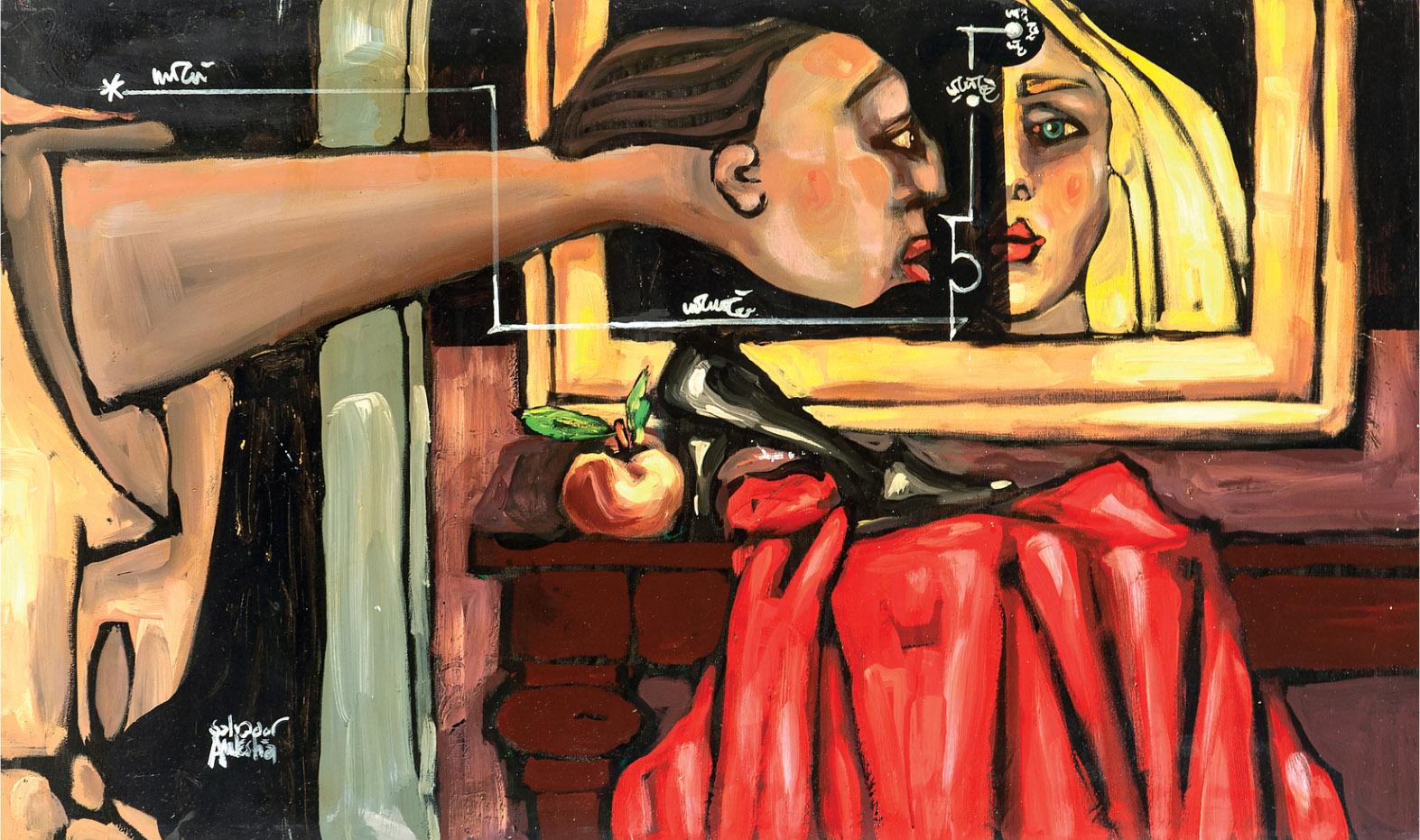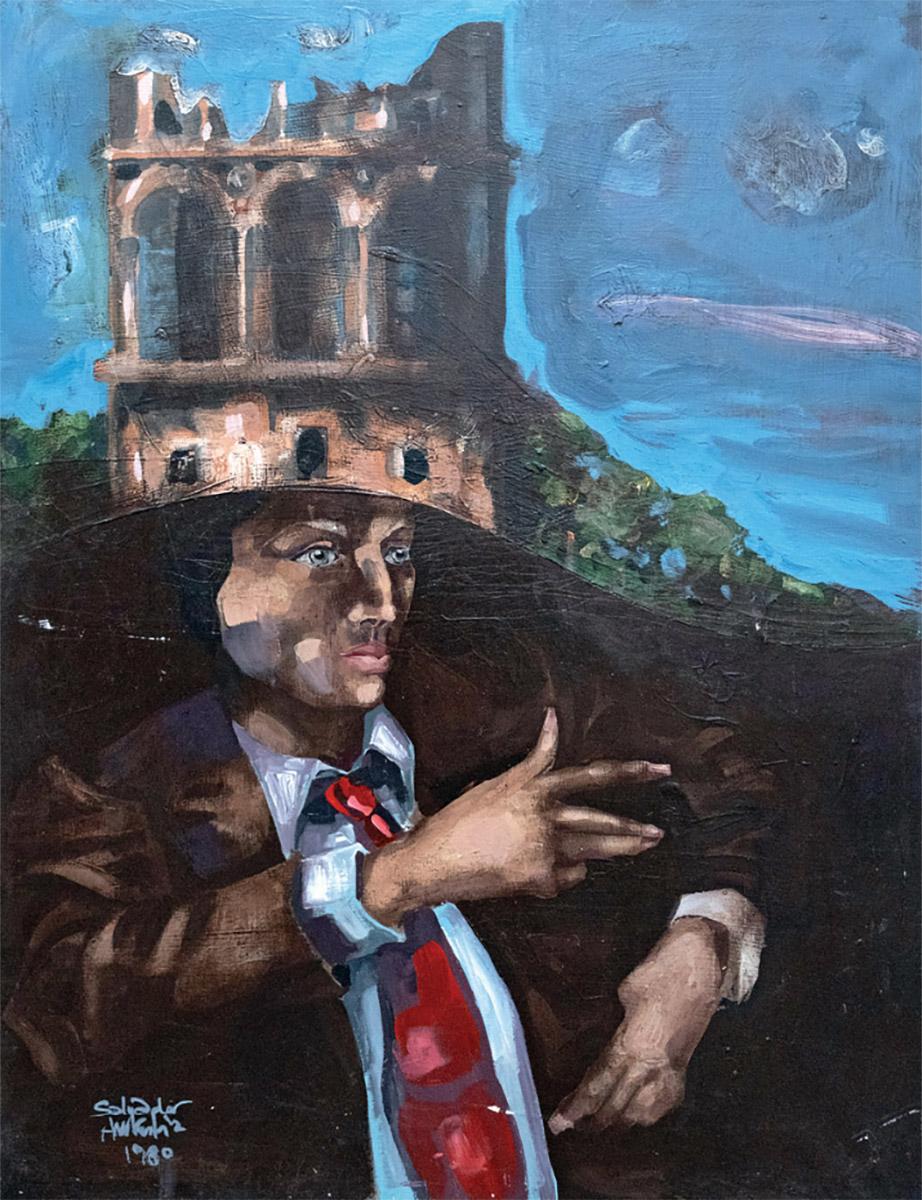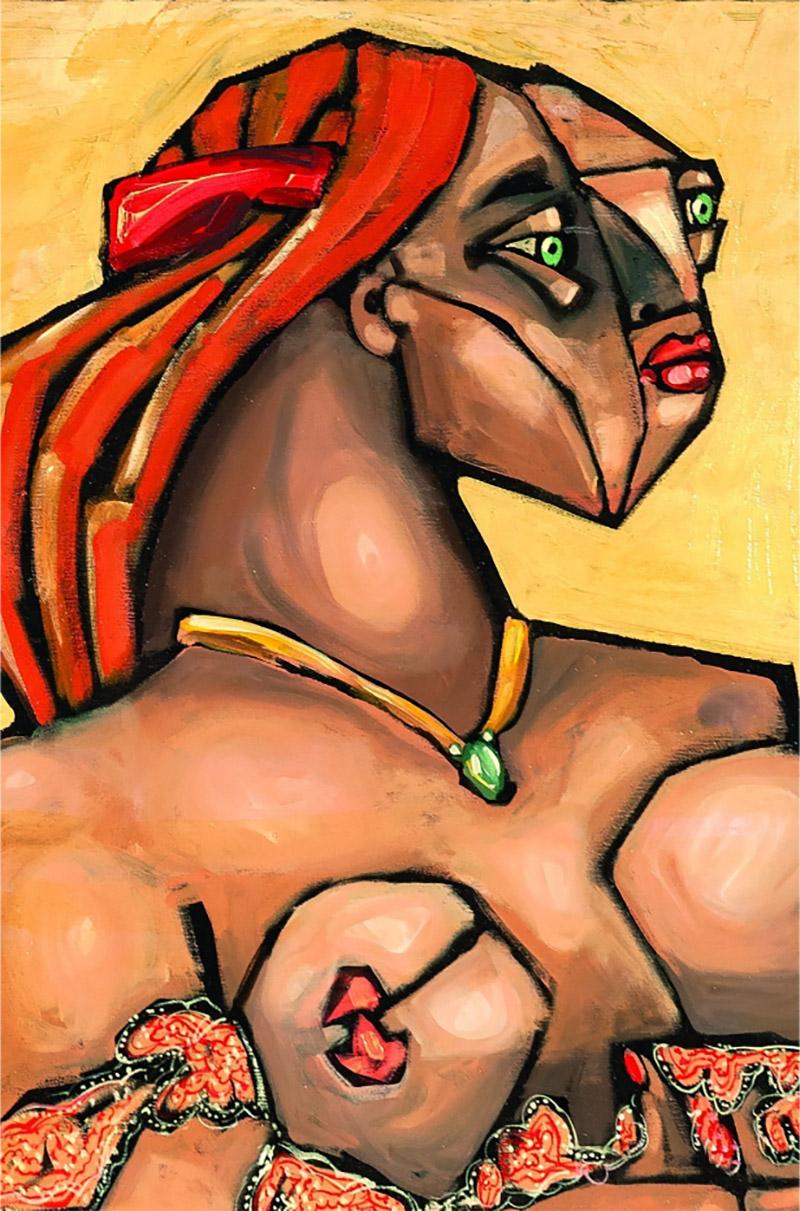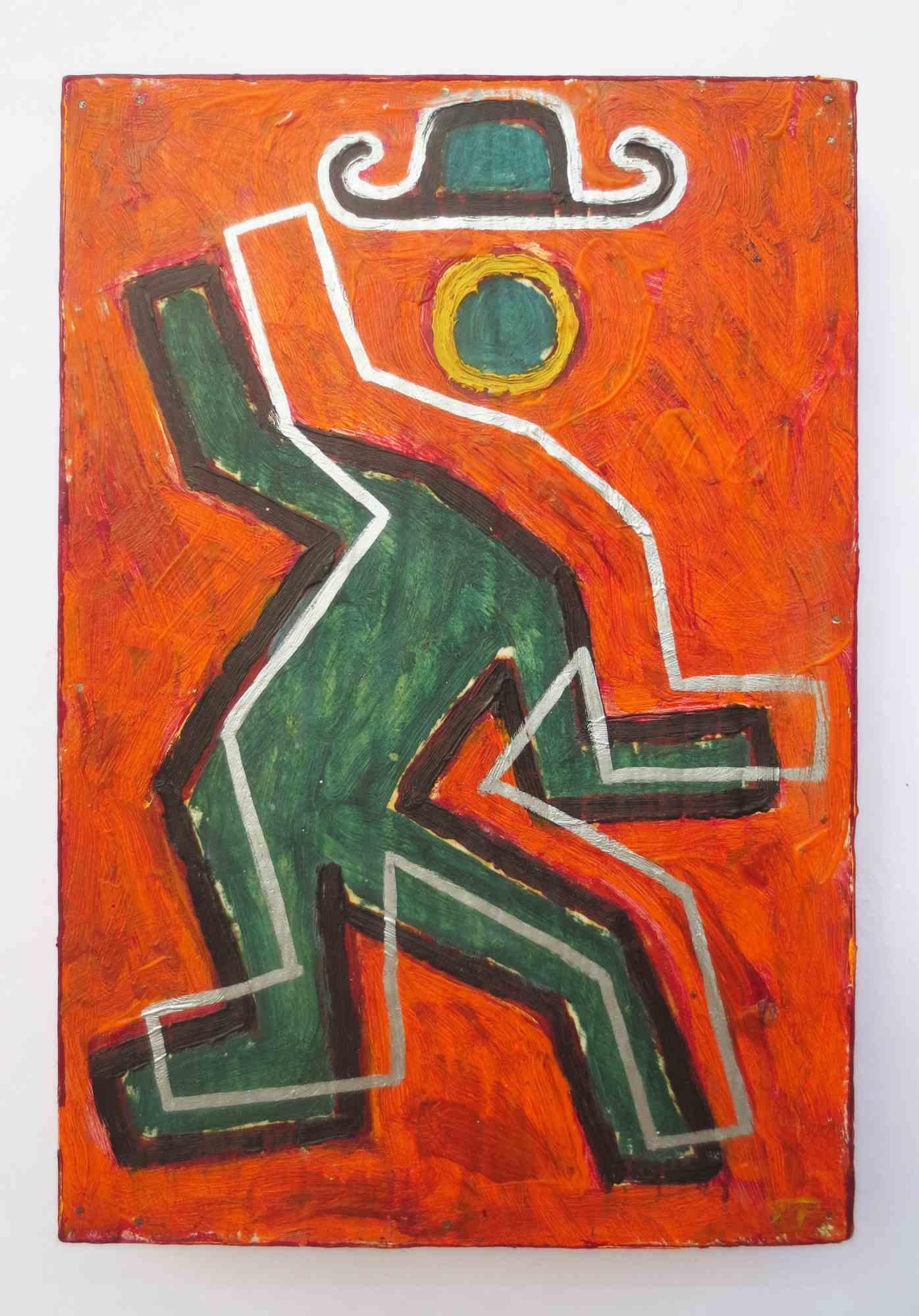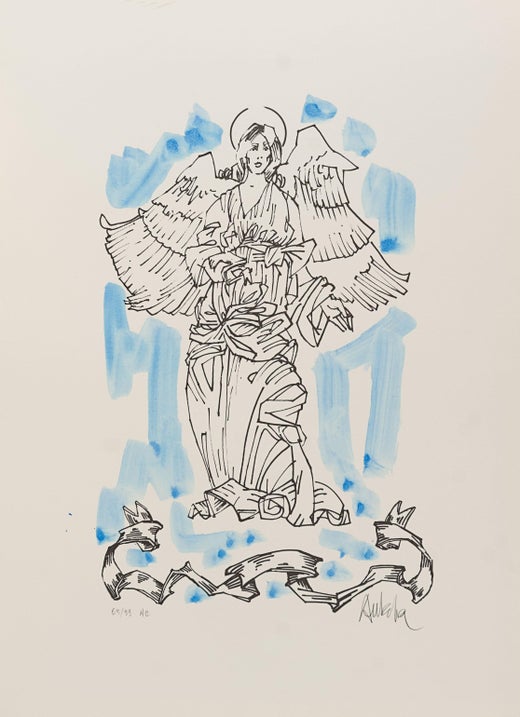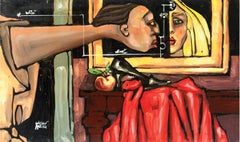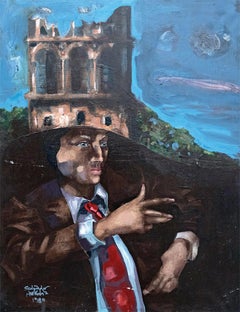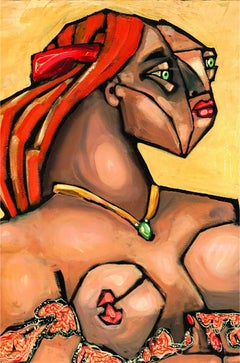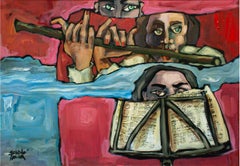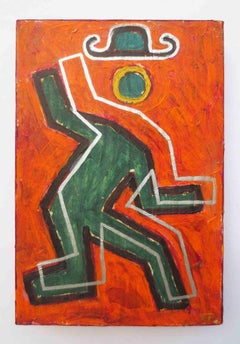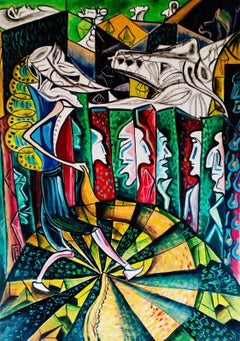Items Similar to Colloquio senza successo -- Salvador Aulestia (1915-1994) - acrylic on canvas
Want more images or videos?
Request additional images or videos from the seller
1 of 9
Salvador AulestiaColloquio senza successo -- Salvador Aulestia (1915-1994) - acrylic on canvas1986
1986
$90,661.26
£67,027.05
€76,000
CA$124,703.20
A$138,615.35
CHF 72,659.20
MX$1,692,828.84
NOK 907,108.14
SEK 853,419.54
DKK 578,586.74
About the Item
This is a masterwork by Salvador Aulestia (Barcelona 1915 - Milano 1994).
There are very few paintings such this one as for rarity than for quality.
Two women on the beach who, as the title suggests, try to strike up a conversation, but to no avail.
The position of the two women, one standing and the other lying down, creates, together with the small red boat in the background, a perfect balance of image.
It embraces the "figurative post-cubism" style.
In fact Salvador Aulestia was artistically grown during the maximum succes of cubism and met Picasso on several occasions and exchanged opinions that, although sometimes divergent, were always constructive.
During his artistic career, he repeatedly crossed over with the Cubist style, often interlacing it with his own ism, Apotism, whose manifesto was promulgated in the 1960s.
On the back ther are several inscriptions made by the artist himself and the symbols that Salvador Aulestia used to identify works of a certain period to avoid counterfeits.
The painting is an acrylic on canvas.
The artwork is accompanied by a certificate of authenticity from the Salvador Aulestia's archive in Milan, the only one authorised by the artist himself by notarial deed to authenticate his works.
It will be shipped in crate with export documents.
This artwork belongs to the Apotism, the particular pictorical style that was presented with the "Manifesto Apotista" by the author himself on May 15, 1965.
Apotism is a name derived from Apotelesmatics (Apotelesmatics is in the plane of Telesma , which here means gnosis, transcendent knowledge). Apotism as an art concept is not a propaedeutic to painting, sculpture, architecture or poetry, rather a Cosmosemiological notion: Cosmos mathematical order, Semiology symbolic order; in practice: astronomical law combined with that of symbol.
Apotism represents the shortest distance between idea and expression; it is an eternal art by essence or the eternal essence of art and has for its axiom the following theoretical message: "Marguerite contemplates the sea, the sun and an old man who contemplates the sea and the sun; but the sea, the sun and the old man, without Marguerite have no reality."
Nietzsche in "Thus Spoke Zarathustra" has the latter utter, while contemplating the rising sun, "How great you are, but were it not for me watching you, you would be nothing."
Marguerite is the "contemplator," a magical element that legalizes the sea, the sun and the old man. "The feminine," says Nietzsche, "is the counterpart of the utopian aspect of reality; that is, what nevertheless remains of magic. In Apotheosis, Marguerite represents precisely this kind of femininity. The axiom "Marguerite contemplates the sea" is the Cubic Stone of Apotism.
- Creator:Salvador Aulestia (1915 - 1994, Spanish)
- Creation Year:1986
- Dimensions:Height: 35.44 in (90 cm)Width: 47.25 in (120 cm)Depth: 1.19 in (3 cm)
- Medium:
- Movement & Style:
- Period:
- Condition:Perfect conditions. Colors are brilliant and lines are well defined.
- Gallery Location:Milano, IT
- Reference Number:Seller: SA_colloquio_senza_successo1stDibs: LU1996210638872
Salvador Aulestia (Barcelona, 1915 - Milan, 1994) belongs with Pablo Picasso, Juan Mirò, Salvador Dali, Antoni Tapies and a few others, to that small group of Spanish authors who have won a leading place in the history of twentieth-century art. His ever-evolving pictorial iter has taken him from classical figurative to pure abstract, figurative abstraction, fauvisme, postcubism, expressionism, and surrealist abstraction, before founding, in 1963, his own current: Apotism, publishing the Manifesto of Apotelesmatic Art. This is an artistic experience that goes beyond the aesthetic, historical and sociological concept of the work of art, as it tends to communicate to the viewer the world of mystery behind ordinary reality. Salvador Aulestia has applied Apotism not only in his work as a painter, draftsman and sculptor, but also in his work as an architect, musician and poet. Exhibitions. After his first exhibition, in 1936, in Barcelona, he held more than 70 solo shows around the world, including, in the 1950s, eight in the United States, between New York and Los Angeles. In Italy, he held, in 1980, a solo show, in Milan, at the Palazzo Reale. He participated in events with the leading artists of his generation. Biennials. Aulestia has been invited to major biennials around the world. Among them, the one in São Paulo ( Brazil), the Spanish-American ones in Barcelona, New York and Paris, as well, of course, as the one in Venice, where, he also represented Spain, in 1968, with a solo room. His works can be found in several museums, including the Museums of Contemporary Art in Barcelona, Madrid and Las Palmas, the Museums of Modern Art in Paris and Bern, the Kunstakademie in Düsseldorf and the Pinacoteca di Brera in Milan. The world's largest iron sculpture. Appreciated as a sculptor, Aulestia created, between 1963 and 1965, what is still the world's largest iron sculpture, "El Sideroploide," 65 meters long and 17 meters high, placed in the port of Barcelona. It should be noted that, unlike most artists, Aulestia did not limit himself to drawing, but forged, with the help of workers at the Port of Barcelona, the work himself. Not only a painter and sculptor, Salvador Aulestia, an architect, designed several public and private buildings in Barcelona and the rest of Catalonia. These include the Infanta Isabel building, a 400-apartment palace with 10 entrances, in which are as many of his two-meter-tall sculptures. He has created sets for the following plays: his friend Eugene Ionesco's Amadeus, de Capmany's Vent de Garbi, and Ibsen's The Idiot. He has published several books in Spain and Italy. Others include "Tauromaquia," the Teraphim and "The Magic of Football," Chiavari Prize in 1982. Appointed Universal Catalan by King Juan Carlos of Spain, Salvador Aulestia has lived in Milan since 1972 where we remember the great exhibition at Palazzo Reale.
About the Seller
No Reviews Yet
Vetted Professional Seller
Every seller passes strict standards for authenticity and reliability
Established in 1998
1stDibs seller since 2022
5 sales on 1stDibs
- ShippingRetrieving quote...Shipping from: Milano, Italy
- Return Policy
Authenticity Guarantee
In the unlikely event there’s an issue with an item’s authenticity, contact us within 1 year for a full refund. DetailsMoney-Back Guarantee
If your item is not as described, is damaged in transit, or does not arrive, contact us within 7 days for a full refund. Details24-Hour Cancellation
You have a 24-hour grace period in which to reconsider your purchase, with no questions asked.Vetted Professional Sellers
Our world-class sellers must adhere to strict standards for service and quality, maintaining the integrity of our listings.Price-Match Guarantee
If you find that a seller listed the same item for a lower price elsewhere, we’ll match it.Trusted Global Delivery
Our best-in-class carrier network provides specialized shipping options worldwide, including custom delivery.More From This Seller
View All"All'indomani dell'incontro" by Salvador Aulestia (Barcelona 1915-Milano 1994)
Located in Milano, MI
Exhibited in Almach Art Gallery Milano during 2023
Hand-signed by artist,
Certificate of authenticity
Included (issued by authorized authenticating body.
Acrylic on canvas
Image r...
Category
1980s Modern Portrait Paintings
Materials
Acrylic, Canvas
"Senza titolo" by Salvador Aulestia (Barcelona 1915-Milano 1994)
Located in Milano, MI
Exhibited in Almach Art Gallery Milano during 2023
Hand-signed by artist,
Certificate of authenticity
Included (issued by authorized authenticating body)
Image rights
Luca Temolo
...
Category
1980s Modern Portrait Paintings
Materials
Acrylic
"Ricordo di un'equazione sentimentale" by Salvador Aulestia
Located in Milano, MI
From the series dedicated to Timeless Women by Salvador Aulestia, this is definitely a museum-grade artwork, exceptionally granted to celebrate yellow, a color well present in the Ca...
Category
1980s Modern Portrait Paintings
Materials
Acrylic, Canvas
"It's better to wake up" by Salvador Aulestia (Barcelona 1915-Milano 1994)
Located in Milano, MI
"It is better to wake up" is a hymn for the "awakening" of humanity.
Hand-signed by artist,
Certificate of authenticity
Included (issued by authorized authenticating body)
Image r...
Category
1980s Modern Portrait Paintings
Materials
Acrylic
"A violent centre" by Salvador Aulestia (Barcelona 1915-Milano 1994)
Located in Milano, MI
This is a perfect example of Salvador Aulestia's Apotist expression.
The arrangement of the subjects on the surface gives them the meaning corresponding to their position by analogy ...
Category
1980s Modern Portrait Paintings
Materials
Acrylic
La Baiadera by Anna Pennati 2010 acrylic painting 60x50cm
Located in Milano, MI
"Danza e Passione" - Exhibition that was displayed in Wilhelmshaven (Germany) , in 2011.
Subsequently, the artwork was included in the exhibition "I Miti e la Danza" displayed in M...
Category
2010s Contemporary Figurative Paintings
Materials
Canvas, Acrylic
You May Also Like
Disequilibrio - Oil Paint by Salvatore Travascio - 2003
Located in Roma, IT
"Disquilibrio" is an oil painting on wood, created by the Italian artist Salvatore Travascio in 2003. It is part of a series of paintings entitled "Instability", a reflection on how ...
Category
Early 2000s Contemporary Figurative Paintings
Materials
Oil, Wood
Disequilibrio - Oil Paint by Salvatore Travascio - 2003
Located in Roma, IT
"Disequilibrio" is an oil painting on wood, created by the Italian artist Salvatore Travascio in 2003. It is part of a series of paintings entitled "Instability", a reflection on how...
Category
Early 2000s Contemporary Figurative Paintings
Materials
Oil
Figurative, pop art oil painting, "Fortuitous Encounters"
By Giancarlo Impiglia
Located in Bridgehampton, NY
A magnificent new oil painting by the great Giancarlo Impiglia that harnesses the rough, reflective quality of aluminum for an entirely unique aesthetic.
Born in Rome, Impiglia mov...
Category
2010s Figurative Paintings
Materials
Metal
CANVAS 17, Painting, Oil on Canvas
Located in Yardley, PA
figurative colorful painting original figurative painting, modern, original acrylic paint on the canvas, abstract modern wall art. framed!! This is original acrylic painting pai...
Category
2010s Contemporary Paintings
Materials
Oil
Antonio Segui - Distraido - Oil on Canvas
By Antonio Seguí
Located in Collonge Bellerive, Geneve, CH
Antonio Segui
38 x 46 cm
Distraido
Oil on Canvas
Signed and Dated on the back
Antonio Segui Biography
Born in Córdoba, Argentina in 1934, Antonio Seguí currently lives and works in Paris. He studied at the San Fernando Academy in Madrid, Spain as well as the Ecole des Beaux-Arts in Paris, France. His first solo exhibition was in Argentina at age 23.
Antonio Seguí is one of the most internationally renowned Argentinian artists. He began his artistic endeavors at a young age after leaving Argentina to travel the world and study art. His journeys through Latin America, Europe and Africa exposed him to new ideas and encouraged his culturally diverse approach to art.
Influenced by artists like Fernand Leger and Diego Rivera, Seguí’s work is generally satirical, critiquing society and human nature. In a pre-computer age, the artist created a vocabulary that is now being explored by a new generation of artists through comics and Manga, yet his visual language and social commentaries remain poignant, both symbolically and literally.
Throughout his career, Seguí has developed a fascination for urban life, creating in his work the idea of the “everyman.” The city movement, the fast pace at which life happens and the people who live in these urban spaces are some of the elements that constitute the world depicted in his paintings. It is a prototypical realm inhabited by speedy automatons that take immutable routes leading nowhere. Up close, each figure is an individual, walking down dark alleys, pointing, waving and emerging from potholes. But from a distance, the individuals morph into complex patterns swallowed up in a labyrinth of buildings and cookie-cutter trees.
Utilizing cubist techniques, Seguí’s repeated elements give shape to the cities causing planes to vibrate between line and color. Numerous perspectives unfold with each vibration and reflect the many angles of life of the urban man. Always in action, the little figures trample, tip-toe, dodge and advance through Seguí’s imaginary metropolis of life.
His work is representated on a series of narratives and criticisms reflected on paintings that show many little men, dressed in 20's style clothes. He uses his own recourse based on comic strip characters, texts, arrows and various signs, juxtaposed onto the figures that resemble comic strip style language.
Seguí’s work is collected and exhibited worldwide in places such as the MoMA, New York; Art Museum of the Americas, Washington, D.C.; Frissiras Museum, Athens, Greece; Museo de Arte Moderno de Buenos Aires, Argentina; Museum der Moderne Salzburg, Austria; Museum of Modern Art Dubrovnik, Croatia; and Museo Tamayo, Mexico City, Mexico. The Musée National d´Art Moderne, Paris organized a retrospective of his works on paper in 2005. A monograph on the artist by Daniel Abadie was published in 2010 by Hazan.
Antonio Segui Resumé
1995
Art Miami '95, USA.
S. Zannettacci, Geneva, Switzerland
Marwan Hoss, Paris, France
Gallerie du Cirque Divers, Belgium
Le Moulin du Roc, France
Fundacao C. Gulbenkaian, Portugal
Gallerie J. Rubeiz, Beirut, Liban
1994
F. Santos, Portugal
E. Franck Gallery, Belgium
1993
Galleria San Carlo, Milan, Italy
Galería I. Vega, Puerto Rico
Winance-Sabbe, Belgium
FIAC, Paris, France
1992
Casa Rosada, Buenos Aires, Argentina
Espace Julio Gonzales...
Category
2010s Modern Figurative Paintings
Materials
Oil
Senza Titolo - Oil Paint by Salvatore Travascio - 1991
Located in Roma, IT
"Senza titolo" is an oil painting on canvas mounted on a wooden frame created by the artist Salvatore Travascio in 1991.
This painting is part of a series of works in which the hum...
Category
1990s Contemporary Figurative Paintings
Materials
Oil, Canvas
More Ways To Browse
1986 Watch
1994 Watch
Portrait Of Marguerite
Used Sea Plane
1965 Watch
1965 Vintage Watch
Red Cross Watch
Cosmos Watch
Flemish Portrait
Mid Century Woman Portrait Painting
English 18th Century Portrait Paintings
Portrait Of Charles I
Military Portrait Paintings
Child Antique Portraits
Abstract Female Portrait Painting
Portrait Of Gentleman
Officer Portrait
Oil Portrait Young Girl
